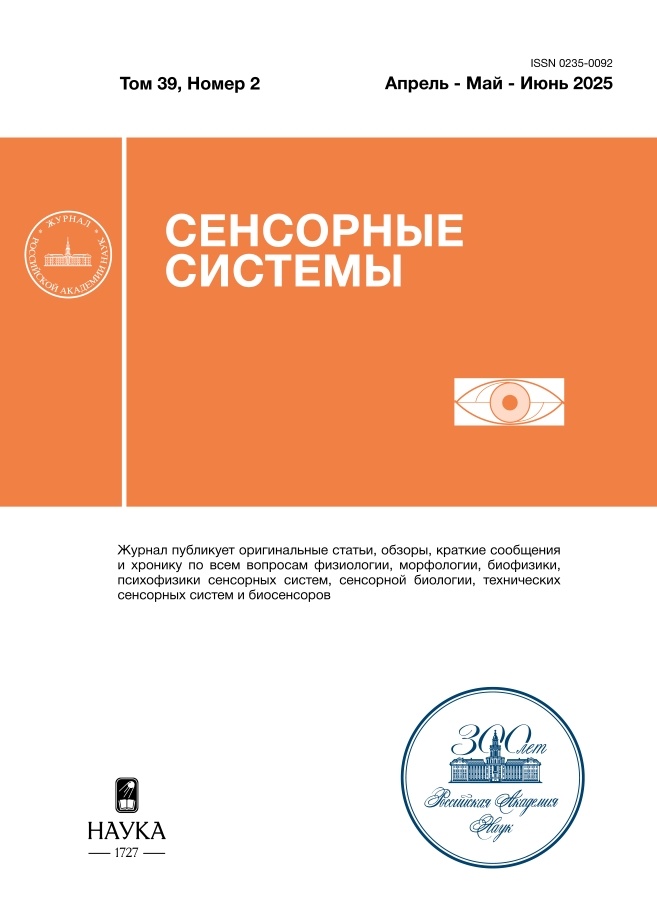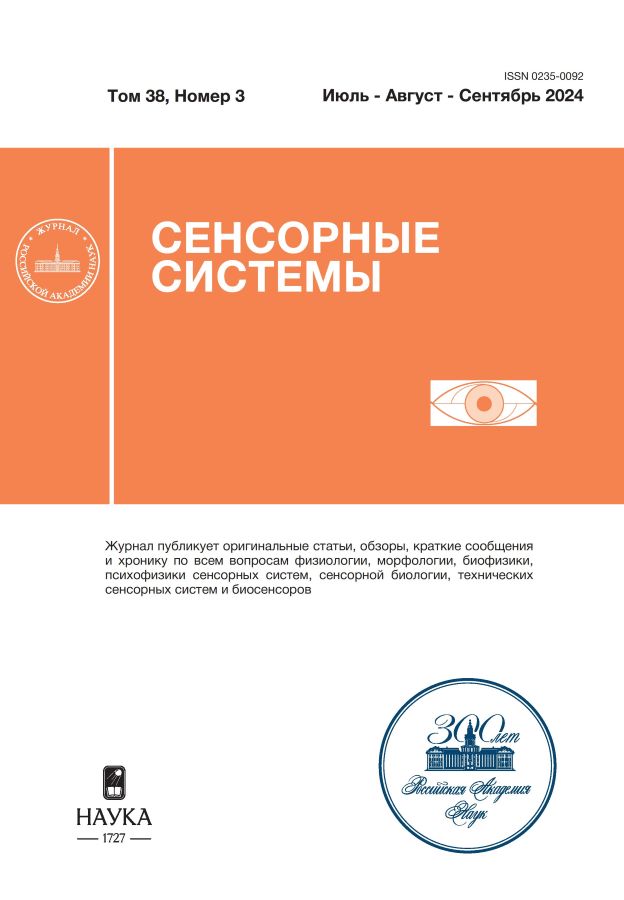Perceived Trajectories of Cyclic Sound Movement
- Authors: Shestopalova L.B1, Petropavlovskaya E.A.1, Salikova D.A.1, Letyagin P.I.1
-
Affiliations:
- Pavlov Institute of Physiology of the RAS
- Issue: Vol 38, No 3 (2024)
- Pages: 51-62
- Section: СЛУХОВАЯ СИСТЕМА
- URL: https://rjonco.com/0235-0092/article/view/675777
- DOI: https://doi.org/10.31857/S0235009224030033
- EDN: https://elibrary.ru/BSBTFP
- ID: 675777
Cite item
Abstract
Binaural beats are a phenomenon that occurs during dichotic stimulation due to binaural integration. It takes the form of cyclic movement of the sound image in the listener’s acoustic space when the beat frequency range is below 3 Hz. Our subjects used the inserted earphones to listen to the stimuli that created a sense of sound movement due to changes in the interaural time difference (ITD). We used three types of dichotic stimuli which simulated smooth azimuthal cyclic movement and cyclic abrupt shifts. The ITD changes determined central or lateral positions of movement trajectories. The results confirm that both types of movement created the effect of binaural beats. The range of beats depended on the spatial position of the trajectory: in the frontal sector of acoustic space, the range of beats was greater than on the left or right. The perceived trajectories of smooth motion were shorter than the trajectories of abrupt shift. The influence of spatial position on the perceived trajectory length is interpreted from the standpoint of nonlinear features of lateralization. It is suggested that the effect of ITD pattern on the perceived trajectory length is mediated by temporal integration mechanisms of binaural hearing.
Full Text
About the authors
L. B Shestopalova
Pavlov Institute of Physiology of the RAS
Author for correspondence.
Email: shestopalovalb@infran.ru
Russian Federation, Saint Petersburg
E. A. Petropavlovskaya
Pavlov Institute of Physiology of the RAS
Email: shestopalovalb@infran.ru
Russian Federation, Saint Petersburg
D. A. Salikova
Pavlov Institute of Physiology of the RAS
Email: shestopalovalb@infran.ru
Russian Federation, Saint Petersburg
P. I. Letyagin
Pavlov Institute of Physiology of the RAS
Email: shestopalovalb@infran.ru
Russian Federation, Saint Petersburg
References
- Altman Ya. A. Prostranstvennyi slukh. SPb: Institut fiziologii im. I.P. Pavlova RAN, 2011. 311 s. (In Russian).
- Andreeva I. G. Posledeystvie dvizheniya kak universal’noe yavlenie dlya sensornykh sistem, uchastvuyushchikh v orientatsii v prostranstve. II. Slukhovoe posledeystvie. Zhurnal evolyutsionnoy biokhimii i fiziologii. 2015. V. 51(3). P. 145–153 (In Russian).
- Blauert I. Prostranstvennyi slukh [Spatial Hearing]. Moscow: Energiya, 1979. 225 p. (In Russian).
- Petropavlovskaia E. A, Shestopalova L. B., Vaitulevich S. F. Predictive ability of the auditory system during smooth and abrupt movements of low-intensity sound images. Journal of higher nervous activity. 2023. V. 61(3). Р. 293–305. (In Russian).
- Salikova D., Petropavlovskaia E., Shestopalova L. Distortion of human auditory space in a dynamic acoustic environment. Integrative Physiology. 2023. V. 4(2). Р. 198–212. doi: 10.33910/2687-1270-2023-4-2-198-212. (In Russian).
- Shestopalova L., Salikova D., Petropavlovskaia Е. Auditory after-effect: stationary adapter changes the perceived trajectories of moving sounds. Journal of higher nervous activity. 2023. V. 73(2). Р. 256–270. (In Russian).
- Barlow H. B. Vision: Coding and Efficiency. A theory about the functional role and synaptic mechanism of visual after-effects. New York. Ed. Cambridge University Press, 1990. Р. 363–375.
- Akeroyd M. A. A binaural beat constructed from noise. J. Acoust. Soc. Am. 2010. V. 128. Р. 3301–3304. doi: 10.1121/1.3505122
- Barlow H. B., Hill R. M. Evidence for a physiological explanation of the waterfall phenomenon and figural after-effects. Nature. 1963. V. 28. Р. 1345–1347. doi: 10.1038/2001345a0
- Basu S., Banerjee B. Potential of binaural beats intervention for improving memory and attention: insights from meta-analysis and systematic review. Psychol. Res. 2022. V. 87(4). Р. 951–963. doi: 10.1007/s00426-022-01706-7
- Bernstein L. R., Trahiotis C. Binaural beats at high frequencies: listeners’ use of envelope-based interaural temporal and intensity disparities. J. Acoust. Soc. Am. 1996. V. 99. Р. 1670–1679. doi: 10.1121/1.414689
- Bernstein L. R., Trahiotis C., Akeroyd M. A., Hartung K. Sensitivity to brief changes of interaural time and interaural intensity. J. Acoust. Soc. Am. V. 2001. V. 109. Р. 1604–1615. doi: 10.1121/1.1354203
- Blauert J. On the lag of lateralization caused by interaural time and intensity differences. Audiology. 1972. V. 11(5). Р. 265–270. doi: 10.3109/00206097209072591
- Carlile S., Leung J. The perception of auditory motion. Trends Hear. 2016. V. 20. Р. 1–19. doi: 10.1177/2331216516644254
- Carlile S., Hyams S., Delaney S. Systematic distortions of auditory space perception following prolonged exposure to broadband noise. J. Acoust. Soc. Am. 2001. V. 110. Р. 416–424. doi: 10.1121/1.1375843
- Clifford C. W., Wenderoth P., Spehar B. A functional angle on some after-effects in cortical vision. Proc. Biol. Sci. 2000. V. 267. Р. 1705–1710. doi: 10.1098/rspb.2000.1198
- Culling J. F., Summerfield Q. Measurements of the binaural temporal window using a detection task. J. Acoust. Soc. Am. 1998. V. 103. Р. 3540–3553. doi: 10.1121/1.423061
- Dingle R. N., Hall S. E., Phillips D. P. The three-channel model of sound localization mechanisms: Interaural level differences. J. Acoust. Soc. Am. 2012. V. 131(5). Р. 4023–4029. doi: 10.1121/1.3701877
- Dingle R. N., Hall S. E., Phillips D. P. The three-channel model of sound localization mechanisms: Interaural time differences. J. Acoust. Soc. Am. 2013. V. 133(1). Р. 417–424. doi: 10.1121/1.4768799
- Garcia-Argibay M., Santed M. A., Reales J. M. Efficacy of binaural auditory beats in cognition, anxiety, and pain perception: a meta-analysis. Psychol. Res. 2019. V. 83(2). Р. 357–372. doi: 10.1007/s00426-018-1066-8
- Getzmann S., Lewald J. The effect of spatial adaptation on auditory motion processing. Hear. Res. 2011. V. 272(1-2). Р. 21–29. doi: 10.1016/j.heares.2010.11.005
- Getzmann S., Lewald J. Cortical processing of change in sound location: smooth motion versus discontinuous displacement. Brain Res. 2012. V. 1466. Р. 119–127. doi: 10.1016/j.brainres.2012.05.033
- Grantham D. W. Detectability of time-varying interaural correlation in narrow-band noise stimuli. J. Acoust. Soc. Am. 1982. V. 72(4). Р. 1178–1184. doi: 10.1121/1.388326
- Grantham D. W. Discrimination of dynamic interaural intensity differences. J. Acoust. Soc. Am. 1984. V. 76(1). Р. 71–76. doi: 10.1121/1.391009
- Grantham D. W., Wightman F. L. Detectability of varying interaural temporal differences. J. Acoust. Soc. Am. 1978. V. 63(2). Р. 511–523. doi: 10.1121/1.381751
- Gutschalk A., Micheyl C., Oxenham A. J. The pulse-train auditory aftereffect and the perception of rapid amplitude modulations. J. Acoust. Soc. Am. 2008. V. 123(2). Р. 935–945. doi: 10.1121/1.2828057
- Kollmeier B., Gilkey R. H. Binaural forward and backward masking: evidence for sluggishness in binaural detection. J. Acoust. Soc. Am. 1990. V. 87. Р. 1709–1719. doi: 10.1121/1.399419
- Licklider J. C.R., Webster J. C., Hedlun J. M. On the frequency limits of binaural beats. J. Acoust. Soc. Am. 1950. V. 22. 468–473. doi: 10.1121/1.1906629
- Maffei L., Fiorentini A., Bisti S. Neural correlates of perceptual adaptation to gratings. Science. 1973. V. 182. Р. 1036–1038. doi: 10.1126/science.182.4116.1036
- McFadden D., Pasanen E. G. Binaural beats at high frequencies. Science. 1975. V. 190(4212). Р. 394–396. doi: 10.1126/science.1179219
- Mills A. W. Lateralization of high-frequency tones. JASA. 1960. V. 32. Р. 132–134.
- Movshon J. A., Lennie P. Pattern-selective adaptation in visual cortical neurons. Nature. 1979. V. 278. Р. 850–852. doi: 10.1038/278850a0
- Perrott D. R., Musicant A. D. Rotating tones and binaural beats. J. Acoust. Soc. Am. 1977. V. 61(5). Р. 1288–1292. doi: 10.1121/1.381430
- Perrott D. R., Nelson M. A. Limits for the detection of binaural beats. J. Acoust. Soc. Am. 1969. V. 46(6). Р. 1477–1481. doi: 10.1121/1.1911890
- Saberi K. Lateralization of comodulated complex waveforms. J. Acoust. Soc. Am. 1995. V. 98. Р. 3146–3156. doi: 10.1121/1.413804
- Salminen N. H., Tiitinen H., May P. J. Auditory spatial processing in the human cortex. The Neuroscientist. 2012. V. 18(6). Р. 602–612. doi: 10.1177/1073858411434209
- Shestopalova L., Petropavlovskaia E., Semenova V., Nikitin N. Brain oscillations evoked by sound motion. Brain Res. 2021. V. 1752. P. 147232. doi: 10.1016/j.brainres.2020.147232
- Shestopalova L., Petropavlovskaia E., 2012 Vaitulevich S., Vasilenko Yu., Nikitin N., Altman J. Discrimination of auditory motion patterns: mismatch negativity study. Neuropsychologia. V. 50. Р. 2720–2729. doi: 10.1016/j.neuropsychologia.2012.07.043
Supplementary files














